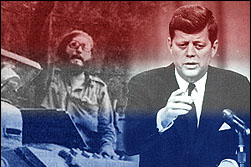
Kennedy gave the
go-ahead for the
invasion three months
into his presidency.
 | Kennedy gave the go-ahead for the invasion three months into his presidency. |
When John Kennedy entered the White House in January of 1961, the training and planning for the exile invasion were nearing completion. The CIA had organized a brigade of about 1,400 exile fighters at a secluded camp in Guatemala, and was infiltrating advance teams of organizers and saboteurs into Cuba. President Kennedy was excited at the prospect of secretly arranging Castro's overthrow, and took an active interest in the planning.
Kennedy was cautious, however, concerned that the size of the operation would threaten his ability to deny U.S. involvement with the exile brigade. Throughout the preparations for the invasion he was enthusiastic about the CIA's Cuba program, but as the planned D-Day approached, Kennedy became increasing worried that the U.S. hand in the operation could no longer be concealed.
Some of Kennedy's advisers shared his concern about the implications of a loss of deniability. A week before the invasion, Kennedy special assistant Arthur Schlesinger, Jr. wrote a memo to the President urging him to not get caught up in covering up the invasion: "When lies must be told, they should be told by subordinate officials. At no point should the President be asked to lend himself to the cover operation."
Kennedy was as determined to have the Cuba program remain secret as he was to see it succeed. The "cover operation" Schlesinger referred to cranked into high gear in mid-April, 1961, as the CIA and the Kennedy administration labored to maintain the fiction that the exiles attacking Cuba were not under the employ of the United states.